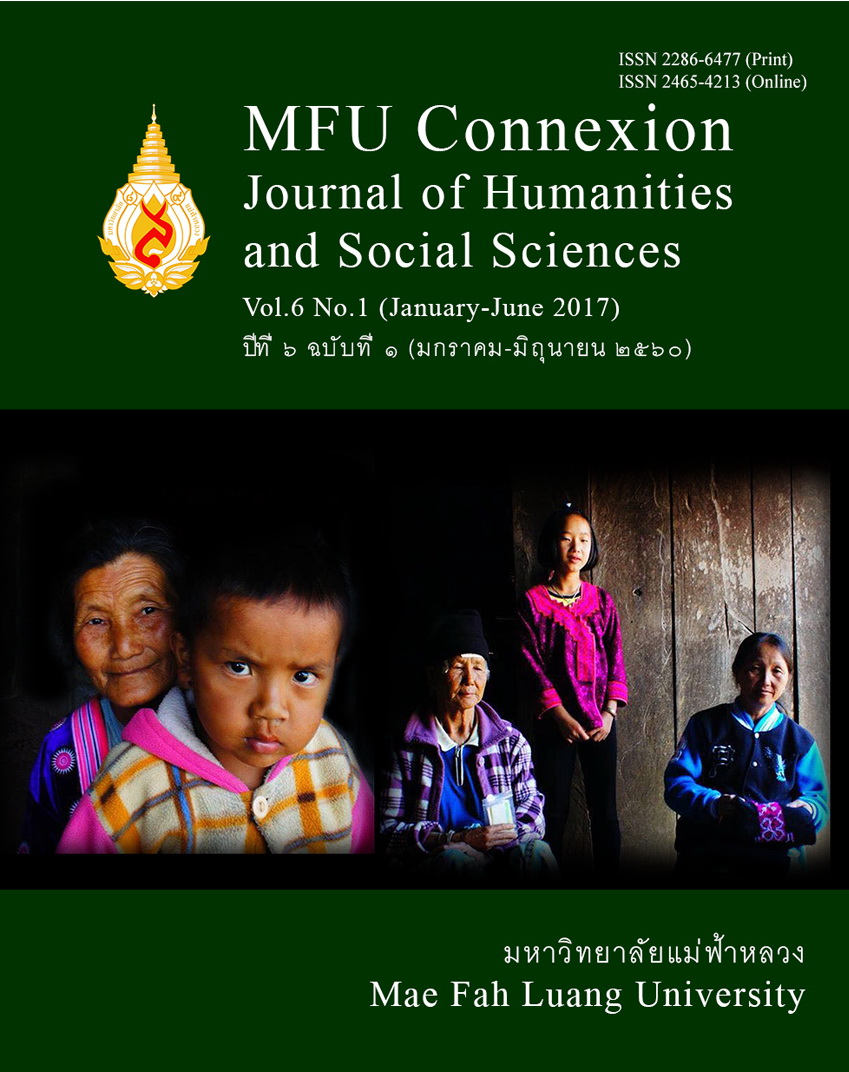Variation in Tai Kinship Terminologies and System in Laos (in Thai)
Main Article Content
Abstract
This research aims to discuss the variations of the terms and systems of basic kinship in Tai languages spoken in Lao People's Democratic Republic (Lao PDR). The languages include Lao, Tai Dam, Tai Daeng, Tai Lue, and Tai Kalom. Data were collected from native informants living in Bokaew and Luang Namtha provinces located at the northwest tip of Laos, and analyzed with the componential analysis approach. The results revealed that the basic kinship systems in such languages contain five dimensions of contrast: generations, linealities, ages, genders, and parental side. All of five languages made no distinction in terms of linealities, ages, genders, and parental side for the third generation above ego (G+3) and the second and the third generation below ego (G-2, G-3), whereas the four dimensions of contrast are found in the first generation above ego (G+1). To make a gender designation in the sex-neutral kinship terms, the terms “caùi”, “ba&ùu”, “waÝùu”, “tsaùi”, or “saùi” are used for male, and “yiN” or “sa&ùu” are used for female.
Article Details
Copyright
Connexion: Journal of Humanities and Social Sciences has an exclusive right to publish the accepted articles in any form. However, the author retains the following rights:
1. The right to the ownership of the article;
2. The right to use all or part of the article in his/her other works;
3. The right to re-produce the article for personal use or for use in the author’s organisation, in which case the author must obtain permission from Connexion: Journal of Humanities and Social Sciences;
4. The right to make copies of all or part of the work for educational use or for the author’s use in classroom teaching; and
5. The right to include the work (both the preprinted and printed versions) in an institutional repository.
References
จตุพร โดมไพรวัลย์. (2555) การเปรียบเทียบระบบคำเรียกญาติในภาษาไทยและภาษาเมี่ยน (เย้า), วิทยานิพนธ์อักษรศาสตรมหาบัณฑิต, มหาวิทยาลัยศิลปากร.
จรัลวิไล จรูญโรจน์, ม.ล. (2542) วัฒนธรรมที่แสดงให้เห็นผ่านคำเรียกญาติในภาษาฮินดี, วารสารอินเดียศึกษา, ปีที่ 5, หน้า 231-251.
ดำรง นันทผาสุข. (2555) การแปรของคำเรียกญาติและ () ในภาษาไทดำ บ้านสะแกราย อำเภอเมือง จังหวัดนครปฐม ตามอายุและทัศนคติต่อภาษา, วิทยานิพนธ์อักษรศาสตรมหาบัณฑิต, จุฬาลงกรณ์มหาวิทยาลัย.
เยาวลักษณ์ เฉลิมเกียรติ. (2542) คำเรียกญาติในจังหวัดนครศรีธรรมราช, วิทยานิพนธ์การศึกษามหาบัณฑิต สาขาวิชาภาษาไทย, มหาวิทยาลัยทักษิณ.
วิภัสรินทร์ ประพันธสิริ. (2535) คำเรียกญาติในภาษาคำเมือง การวิเคราะห์ทางอรรถศาสตร์ชาติพันธุ์, วิทยานิพนธ์อักษรศาสตรมหาบัณฑิต, จุฬาลงกรณ์มหาวิทยาลัย.
วิไลวรรณ ขนิษฐานันท์ และคณะ. (2540) สารานุกรมไทยสำหรับเยาวชน เล่ม 22, กรุงเทพฯ: รุ่งศิลป์การพิมพ์.
สมทรง บุรุษพัฒน์. (2543) ภูมิศาสตร์ภาษาถิ่น, กรุงเทพฯ: เอกพิมพ์ไทย.
สมทรง บุรุษพัฒน์. (2556) การแปรและการเปลี่ยนแปลงเสียงในภาษาไทยโซ่ง, นครปฐม: มหาวิทยาลัยมหิดล.
สุริยา รัตนกุล. (2548) นานาภาษาในเอเซียอาคเนย์: ภาษาตระกูลไท, กรุงเทพฯ: สหธรรมิก.
สุวัฒนา เลี่ยมประวัติ. (2551). การศึกษาภาษาถิ่น: ภาษาตระกูลไท. นครปฐม: มหาวิทยาลัยศิลปากร.
อมรชัย คหกิจโกศล. (2548) การเปรียบเทียบคำเรียกเครือญาติในภาษาไทยและภาษาจีนแต้จิ๋ว, ดำรงวิชาการ, ปีที่ 4, ฉบับที่ 1, หน้า 1-23.
Boonsawasd, A. (2013) Chinese influence on Bouyei basic kinship terms, Dialectologia, vol. 11, pp. 67-84.
Fippinger, D. C. (1971) Kinship terms of the Black Tai people, Journal of the Siam Society, vol. 59, pp. 65-82.
Goodenough, W. H. (1956) Componential analysis and the study of meaning, Language, pp. 195-216.
Li, F. (1960) ‘A tentative classification of Tai dialects’, in S. Diamond, (ed.), Culture in history: Essays in honor of Paul Radin, pp. 951-959, New York: Columbia University Press.
Lounsbury, F. G. (1964) ‘The structural analysis of kinship semantics’, in H. G. Lunt (ed.), Proceedings of the ninth international congress of linguistics, pp. 1073–1093, Mouton: The Hague.
Nida, E. A. (1979) Componential analysis of meaning: An introduction to semantic structures, New York: Mouton Publisher.
Prasithrathsint, A. (1996) ‘A comparative study of the Thai and Zhuang kinship system’, in Collection of Papers on the Relationship between the Zhuang and the Thai, pp. 12-32, Bangkok: Chulalongkorn University Press.
Prasithrathsint, A. (2001) ‘A componential analysis of kinship terms in Thai’, in K. Tingsabadh & A. S. Abramson (eds.), Essays in Tai linguistics, pp. 261-276, Bangkok: Chulalongkorn University Press.
Schliesinger, J. (2003) Ethnic groups of Laos, volume 3 profile of Austro-Thai-speaking peoples, Bangkok: White Lotus.
World Bank. (2006) Lao PDR: Poverty assessment report. From valleys to hilltops: 15 years of poverty reduction, Washington, DC: World Bank.


